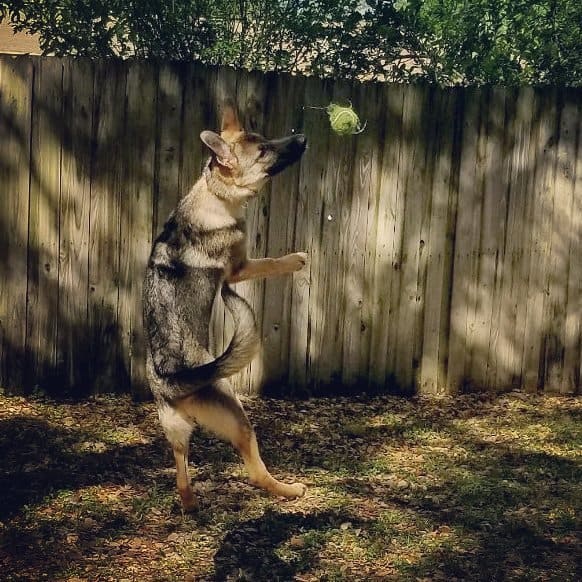Why you should start training a German Shepherd at a young age. How to begin with training a puppy and get a running start.
If you don’t know anything about raising a puppy, chances are that you have a lot of questions. Everyone has to have their first puppy and, just like with having a first child, there is a lot of learning involved. You’re bound to make some mistakes with your first puppy and that’s okay.
If there’s one thing you need to know about puppy-rearing before your new family member comes home, it’s this: Puppies do better with a routine. 8 weeks and Beyond! How To Get Started The Right Way.
What age should you start training a German Shepherd?
 Whether you have a puppy or an older German Shepherd. It’s best to start training at a young age. I have learned that starting as soon as you bring your puppy home. This will prevent behavior problems from developing.
Whether you have a puppy or an older German Shepherd. It’s best to start training at a young age. I have learned that starting as soon as you bring your puppy home. This will prevent behavior problems from developing.
Some people start at 8: weeks to 12 weeks or four months to six months of age depending on how old the puppy was when they purchased.
I put together a beginner mini-guide below- to help you get started with a new puppy. You want to get your puppy on the right training schedule. All German Shepherds do good when they’re on a consistent schedule. How to housebreak a German Shepherd puppy?
How To Potty Train A German Shepherd Puppy?
Step-By-Step-Potty Training Schedule:
I’ve used this with all my puppies. It works.
Morning
The first thing that you should do is let your puppy out of its crate and take it directly outside to go potty. Because the crate you choose will only be large enough for your puppy to stand, sit, lie down and turn around comfortably, it shouldn’t have eliminated during the night without alerting you to its need to go. By the time morning rolls around, peeing and pooping will be the first item on your pup’s agenda.
After your puppy has gone outside, it’s time for breakfast. An eight-week-old puppy needs to eat three to four meals each day. Figure out your puppy’s daily caloric needs and divide that number into three to decide how much you will feed at each meal. Your puppy should be given a bowl of water with its meal and be permitted to drink as much as it wants. Give your puppy about ten minutes to relax after it has eaten and then go back outside for potty.
Before its next meal, your puppy should be taken out every hour in order to prevent accidents and should be placed into its crate whenever it will not be directly supervised. Crates are great for everyday use as they keep your puppy out of danger when it is not by your side.
Afternoon
Your afternoon will mirror your morning almost exactly. Your puppy will need to be taken outside if it has been crated, fed its afternoon meal and then taken outside again. When not being supervised, your puppy should be gated off into a completely puppy-proofed room or crated. Don’t forget to take your puppy out at least once an hour to prevent accidents on your floor.
Evening
If you’re starting to see a pattern emerge in your day, you’ll already have figured out that your evening will be the same as your morning and afternoon. Your puppy will get a meal, go outside, and be placed in a safe room or crate when not supervised. You’ll go to bed, wake up in the morning and start all over again.
Throughout the day, use your puppies name in connection with positive things. This will help your puppy learn his name more quickly. For instance, when your puppy sits on his own, you should say “good sit, Spot!” and give him a treat. When it’s time for your puppy to go potty, say “Spot, let’s go potty!” The more often you use your pup’s name in a positive way, the quicker he’ll understand that the word you keep using is its name.
Having a puppy in the house is fun for everyone in the family. Your job is to make sure that the puppy is given a predictable, structured environment to grow up in. If you do this, you’ll have a great adult on your hands in no time.
German Shepherd Puppy Training:
Training a puppy at a young age will prevent bad behavior from developing into big-time behavior problems. We don’t want this to happen. It’s best to start when you bring your puppy home at whatever age you get them at. Some of us start at eight weeks, others start at 10 to 12 weeks old.
Here’s a mini-guide to get you started. 10 weeks to six months old.
Laying out the groundwork for leash training a puppy. With step by step video training guide.
Video one; Leash training your puppy will be one of the first things you and I will need to do with our new German Shepherd puppy!. Learning can be a challenge for many of us. Today I like to share a video with my friend Tonny and his new puppy Named Nora at 10 weeks old. This her first leash training exercise. In the video, you’ll learn how we’re using food as her reward when teaching her how to stay in position when we are practicing the heel exercise.
What I have learned from my own experience;
I like to practice this exercise 2 or 3 times a day for 4 to 6 minutes at a time every day- when training young pups at this age. Puppies have a short attention span, we don’t want to overtrain a young puppy. Sometimes we as humans expect too much too fast and can forget what we learn from owning our last dog.
We forgot puppyhood. I know I have made this mistake before. I have learned after training multiple German Shepherd puppies, how to spend a good enough amount of time working them by training shot training sessions to get the best results.
3 and a half-month-old German Shepherd puppy;
Video Two: Now that Nora is 3 and a half-month-old. Tony and his wife Shannon are teaching her how to walk on a leash in the street under real-world distractions. If you have never trained a puppy before learning these training skills will be challenging for anybody just learning. But done let it stop you from practicing.
With just a little bit of time and patience, you and your puppy will come a long way together. I have learned this is the most important part of training our puppy and will build and strengthens our bond together for starting our new journey.
Video Three: Nora, is now a 4/12-month-old GSD puppy. In this video, Shannon is learning how to add the sit/ stay command into her heel training exercise when practicing. Once your puppy is showing that they are understanding what the heel command means, now we can start to add in the sit-stay command. This is a command we will use every day with our puppy.
Watch how Shannon works with her puppy in this video. Nora will get a little distracted when she is walking by me and her husband Tony. You’ll learn how we fix that by going the opposite direction with her. If you’re a first time German Shepherd owner, and never trained a puppy before, don’t let this frustrate you it’s just something we all go through when raising and training a German Shepherd puppy.
PS: The more places we go and practice our training with our puppy, the more confidence you”ll build in your dog. It’s our responsibility to teach our dogs what we want them to learn no matter where we take them. When you take your dog out to Real World locations to practice working with your dog, remember it’s going to be a new challenge for you and your dog.
Dog training is all about doing things together as a team. Building trust and leadership with your new best friend. It’s a great feeling when you can take your dog everywhere you go.
Always start off with your attention training and practicing around your home and in your yard. Your dog will pick up on your energy level and trust me they know how you feel, so it’s important for you to be comfortable and confident in what you doing when you’re practicing your obedience training with your puppy. A little bit of practice goes a long way.
Your homework, go and practice and come back to this post a comment and let me know how you’re doing. I would love to hear about all your success.
I will be sharing more training videos with you soon! Best of luck with your training.

